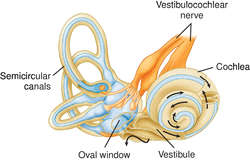Medical term:
cochlea
cochlea
[kok´le-ah]a spiral tube shaped like a snail shell, forming part of the inner ear; it is the essential organ of hearing. adj., adj coch´lear.
The cochlea is filled with fluid and is connected with the middle ear by two membrane-covered openings, the oval window (fenestra vestibuli) and the round window (fenestra cochleae). Inside it is the organ of corti, a structure of highly specialized cells that translate sound vibrations into nerve impulses. The cells of this organ have tiny hairlike strands (cilia) that protrude into the fluid of the cochlea.
Sound vibrations are relayed from the tympanic membrane (eardrum) by the bones of hearing in the middle ear to the oval window, where they set up corresponding vibrations in the fluid of the cochlea. These vibrations move the cilia of the organ of Corti, which then sends nerve impulses to the brain.
The cochlea is filled with fluid and is connected with the middle ear by two membrane-covered openings, the oval window (fenestra vestibuli) and the round window (fenestra cochleae). Inside it is the organ of corti, a structure of highly specialized cells that translate sound vibrations into nerve impulses. The cells of this organ have tiny hairlike strands (cilia) that protrude into the fluid of the cochlea.
Sound vibrations are relayed from the tympanic membrane (eardrum) by the bones of hearing in the middle ear to the oval window, where they set up corresponding vibrations in the fluid of the cochlea. These vibrations move the cilia of the organ of Corti, which then sends nerve impulses to the brain.
Miller-Keane Encyclopedia and Dictionary of Medicine, Nursing, and Allied Health, Seventh Edition. © 2003 by Saunders, an imprint of Elsevier, Inc. All rights reserved.
coch·le·a
, pl.co·chle·ae
(kok'lē-ă, lē-ē), [TA]The snail shell-shaped dense bone in the petrous portion of the temporal bone, forming the anterior division of the labyrinth or internal ear (bony cochlea). It surrounds a spiral canal of two-and-one-half turns around a central core, the modiolus; this spiral canal contains the scala vestibuli, scala media consisting of the membranous cochlea or cochlear duct in which is located the spiral organ (Corti), and scala tympani. The scala vestibuli is separated from the scala media by the Reissner membrane, and the basilar membrane separates the scala media from the scala tympani.
[L. snail shell]
Farlex Partner Medical Dictionary © Farlex 2012
cochlea
(kŏk′lē-ə, kō′klē-ə)n. pl. coch·leae (-lē-ē′, -lē-ī′) also coch·leas
A spiral-shaped cavity of the inner ear that resembles a snail shell and contains nerve endings essential for hearing.
coch′le·ar adj.
The American Heritage® Medical Dictionary Copyright © 2007, 2004 by Houghton Mifflin Company. Published by Houghton Mifflin Company. All rights reserved.
bony labyrinth
The bone encasement of the inner ear which is filled with perilymph and contains 3 cavities:(1) The cochlea, which houses the sensory part of the auditory system;
(2) The semicircular canals, which are sensitive to rotational movement;
(3) The vestibule, which contains the sacculus and utriculus, which are sensitive to linear movement.
Segen's Medical Dictionary. © 2012 Farlex, Inc. All rights reserved.
coch·lea
, pl. cochleae (koklē-ă, -ē) [TA]A conic cavity in the petrous portion of the temporal bone, forming one of the divisions of the labyrinth or internal ear. It consists of a spiral canal making two-and-a-half turns around a central core of spongy bone, the modiolus; this spiral canal of the cochlea contains the membranous cochlea, or cochlear duct, in which is the spiral organ (Corti organ).
[L. snail shell]
Medical Dictionary for the Health Professions and Nursing © Farlex 2012

STRUCTURES OF THE COCHLEA
cochlea
(kŏk′lē-ă) [Gr. kokhlos, land snail]A winding cone-shaped tube forming a portion of the bony labyrinth of the inner ear. It contains the organ of Corti, the receptor for hearing.
See: illustrationcochlear (-ăr), adjectiveThe cochlea is coiled, resembling a snail shell, winding two and three quarters turns about a central bony axis, the modiolus. Projecting outward from the modiolus, a thin bony plate, the spiral lamina, partially divides the cochlear canal into an upper passageway, the scala vestibuli, and a lower one, the scala tympani. Between the two scalae is the cochlear duct, the auditory portion of the membranous labyrinth. The spiral organ (of Corti) lies on its floor. The base of the cochlea adjoins the vestibule. At the cupola or tip, the two scalae are joined at the helicotrema.
Medical Dictionary, © 2009 Farlex and Partners
cochlea
The structure in the inner ear containing the coiled transducer, the organ of Corti, that converts sound energy into nerve impulse information. The cochlea resembles a snail shell.Collins Dictionary of Medicine © Robert M. Youngson 2004, 2005

Fig. 110 Cochlea . Cross section.
cochlea
a part of the inner ear which is concerned with the detection of the pitch and volume of sound received by the ear. A projection of the SACCULE (2), it occurs in some reptiles, birds and mammals. In the mammal it is a coiled tube consisting of three parallel canals and contains the organ of Corti, the part which actually responds to sound.Collins Dictionary of Biology, 3rd ed. © W. G. Hale, V. A. Saunders, J. P. Margham 2005
Cochlea
The hearing part of the inner ear. This snail-shaped structure contains fluid and thousands of microscopic hair cells tuned to various frequencies, in addition to the organ of Corti (the receptor for hearing).
Mentioned in: Cochlear Implants, Ototoxicity, Stapedectomy
Gale Encyclopedia of Medicine. Copyright 2008 The Gale Group, Inc. All rights reserved.
coch·lea
, pl. cochleae (koklē-ă, -ē) [TA]Snail shell-shaped dense bone in the petrous portion of the temporal bone, forming the anterior division of the labyrinth or internal ear.
[L. snail shell]
Medical Dictionary for the Dental Professions © Farlex 2012
Latest Searches:
veneniferous - venenation - venenata - veneered - veneer - venectomy - venectasia - venation - Venastat - venarum - VenaFlow - venae - venacavography - venacavogram - venacaval - vena - velum - Veltin - Veltap - Velpeau -
- Service manuals - MBI Corp